The Red and Washita River drainages were dammed in 1944 to create Lake Texoma, a lake situated mostly in Oklahoma, with a portion of it also in Texas. Little did the WWII German prisoners-of-war who helped construct the massive dam know that the 80,000 acres they were helping to impound would one day become a world-class striped bass fishery that would attract striper anglers from all across the country. I’m pretty sure the biologists in charge of the new fishery had no idea what was to come, either.
Stripers were first stocked in 1965. The salt mines 40 miles upstream on the Red River provided the nearly perfect salt level to keep the striper eggs buoyant during the annual spring spawn. That helped striper stockings flourish, and upon reaching maturity, they made their spawning runs up the Red and Washita Rivers. The rest, as they say, is history.
Ask any serious striped bass angler from the Chesapeake Bay to Texas about the great fishing at Texoma. Chances are very good that they have already fished there or that those rich, emerald-green waters are on their hit list. There are a few other inland reservoirs with a documented striper spawn, but none with the regularity or success of Lake Texoma. Because striped bass is a saltwater species that make their annual spawning runs up brackish rivers, the salinity of the river feeding Texoma is the major reason for the striper success story here.
Staying current on patterns is key to any type of fishing, but that’s especially so when fishing for striped bass. These aggressive schooling fish are constantly on the move in search of the lake’s plentiful forage baitfish. Find the shad and you are well on your way to catching stripers.
Getting Hooked
When discussing striped bass fishing and Lake Texoma, the name Bill Carey and his guide service, Striper Express, often dominate the conservation. Bill began fishing Texoma about 40 years ago. He’s a storehouse of knowledge about everything related to catching striped bass. A native of East Texas, where largemouth bass fishing is king, Bill was a devout bass fisherman. But once he fought his first striper, he was, as he says, “hooked for life.”
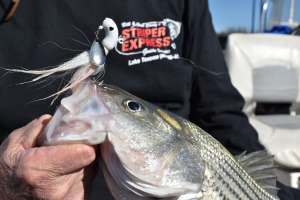 Bill began his striper guide service 39 years ago and it’s currently the longest-running and largest charter service on the lake. For the past several decades, I have done most of my striper fishing with Bill and his son, Chris, who grew up on the lake (and who, I jokingly say, “thinks like a fish”).
Bill began his striper guide service 39 years ago and it’s currently the longest-running and largest charter service on the lake. For the past several decades, I have done most of my striper fishing with Bill and his son, Chris, who grew up on the lake (and who, I jokingly say, “thinks like a fish”).
Regardless of the species, the very best way to know what the fish are doing and staying current on patterns is by being on the water. With four to six boats out daily and all in constant communication, Bill and his crew track the striper patterns throughout the year.
Fall is one of my favorite times of the year to catch stripers. The kazillions of shad that spawned several times through the warm weather months have dispersed widely over the lake. Seagulls have migrated in from the coast to enjoy the abundant food source. Fall fishing is all about big schools of stripers chasing even bigger schools of shad to the surface, and seagulls pointing the way to the action. Gulls have sonar-like eyes that can spot the shad under the surface, as well as doing surface fishing. They are a fisherman’s best friend this time of year.
As Bill Carey says, “We never leave the dock without good binoculars, and with all the state-of-the-art sonar on our boats, binocs are often the only fish finder we need. It’s common to spot several big schools of feeding stripers this time of year.”
Tactics and Jigs
Technique is important. Jigs such as the Roadrunner are one of the top baits. However, aggressively feeding fish can be tricked with anything from big noisy topwater jigs, such as a Zara Spook or a Pencil Popper, to a lead spoon. Fishing with two rods—one rigged with a topwater plug and the other with a jig—is a very effective method for boating stripers this time of year.
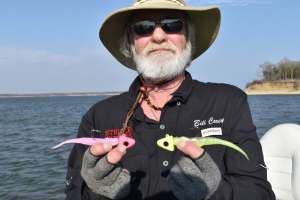 When the fish sound and the top water bite ceases, the gulls will continue to point the way to the sub-surface striper school. The fish are still in feeding mode and will often readily nail a jig or a spoon dropped into their midst. Savvy anglers pack jig heads ranging in size from one to two ounces and soft body plastic four to six inches in length, depending on the size of baitfish the stripers are targeting. Chartreuse is a go-to color on Texoma, but white or variations of white and chartreuse are also effective. On windy days, the heavier jigs are easier to cast and fall into the strike zone faster. With little or no wind, ¾-ounce jigs can get the job done.
When the fish sound and the top water bite ceases, the gulls will continue to point the way to the sub-surface striper school. The fish are still in feeding mode and will often readily nail a jig or a spoon dropped into their midst. Savvy anglers pack jig heads ranging in size from one to two ounces and soft body plastic four to six inches in length, depending on the size of baitfish the stripers are targeting. Chartreuse is a go-to color on Texoma, but white or variations of white and chartreuse are also effective. On windy days, the heavier jigs are easier to cast and fall into the strike zone faster. With little or no wind, ¾-ounce jigs can get the job done.
In the fall during periods of cloud cover, the top water often lasts throughout the day, and it’s possible to see several schools “busting” the surface. Boat approach is important when fishing these surface-feeding schools. The key is to approach from upwind, shut the big engine off and let the wind push the boat into the strike zone. Once the school has passed, keep an eye on the birds to point the direction the school is traveling. Then, fire up the engine and repeat the process.
When only a couple of anglers are fishing, trolling with umbrella rigs can be highly effective, especially in late summer. Small, flashy spinners rigged with soft plastics that are three to four inches long can be highly effective in triggering reaction bites when stripers are not actively feeding. Having five or six baits moving through the water column via the umbrella rig mimics a small school of baitfish.
Winter Fishing
When winter arrives on Texoma, fishing continues to be very good. By December, thousands of gulls have arrived to point fishermen to the feeding schools. As the water temperature drops into the 50s, less surface feeding action occurs, but stripers are still chasing shad. The birds continue to be a major factor in locating roving schools of feeding fish.
Live shad is always a “go-to” bait for those willing to depend on catching bait with a cast net and keeping them alive with an aerated bait tank. Shad “go deep” in the winter months, so catching enough to fish with can be a challenge. The good news is that those jig heads rigged with soft plastics continue to be deadly, even in the colder weather. Stripers use the submerged river channels as travel routes to and from the spawning waters above the lake. It’s common to see boats anchored on the submerged river ledges and fishermen doing vertical fishing with live shad. Guides often tie their boats together in a string, since having more baits in the water catches the attention of stripers roving up and down the channels.
Cold-Weather Wins
Some of the biggest stripers of the year are landed during the coldest months. Carey and his team of guides target shallow water with both topwater plugs and jigs during the winter. When the water temperature warms a degree or two in the shallows (2 to 3 feet deep) both bait and stripers move into the comfort zone. Throwing big topwater baits and jigs in these areas is not a numbers game for catching lots of stripers. It’s more of a technique for catching trophy-class fish. Just like when hunting for trophy Whitetail, a person has to be patient and put in the time.
The striper spawn at Texoma is a drawn-out affair. Not all spawning stripers make their runs up river above the lake at the same time. By April, a great deal of the catching occurs when stripers are either staged at the mouth of the rivers and heading upstream or coming down post-spawn and hungry! As the waters warm in early summer, the cycle repeats itself. Texoma is truly a year-round striper fishery. It’s one that I recommend needs to be on the hit list of every serious angler.
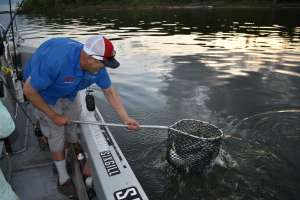
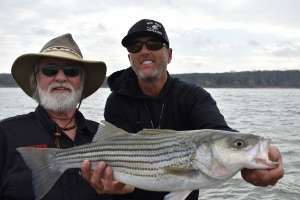 There is no minimum length limit for striped bass. The daily bag limit is 10 and the possession limit is 20. Only two striped or hybrid-striped bass 20 inches or greater may be retained each day.
There is no minimum length limit for striped bass. The daily bag limit is 10 and the possession limit is 20. Only two striped or hybrid-striped bass 20 inches or greater may be retained each day.
Since Lake Texoma is located in both Texas and Oklahoma, a special Lake Texoma fishing license is required. Licenses are readily available locally or online.
If you’d like to arrange guided fishing trips or for more information, contact Bill Carey at Striper Express.



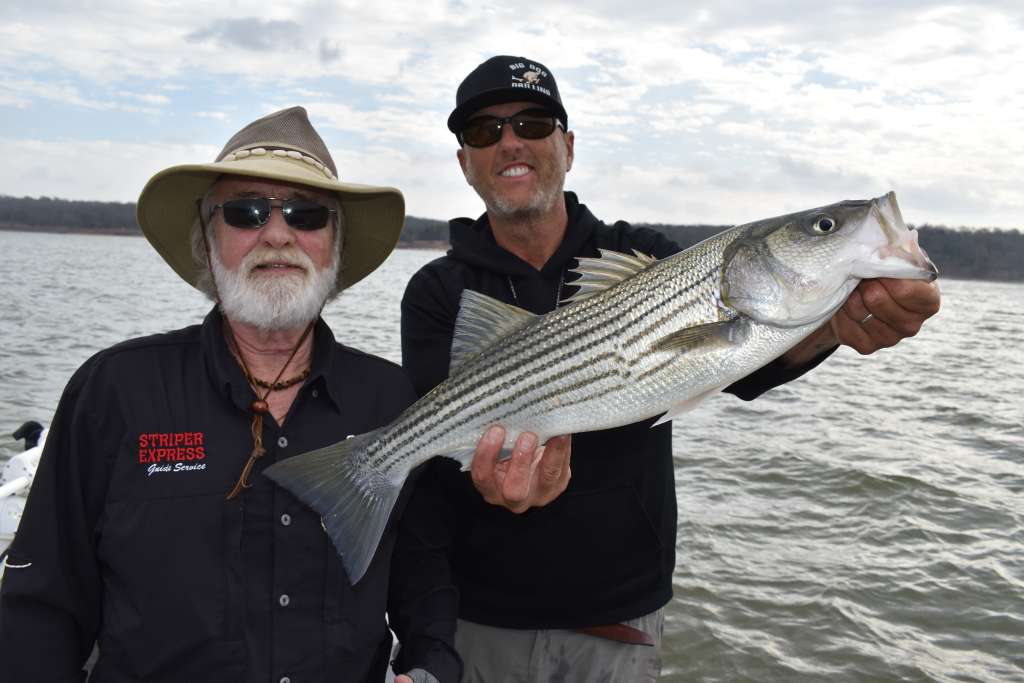
6 Comments
wg2hqw
2ysvbh
yry3wh
9nxzhl
svolf1
g34yj9